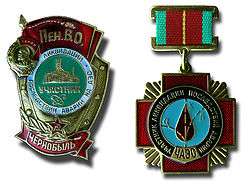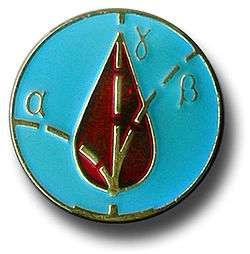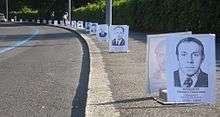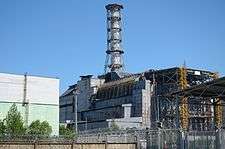Chernobyl liquidators


Liquidators were the civil and military personnel who were called upon to deal with consequences of the 1986 Chernobyl nuclear disaster in the Soviet Union on the site of the event. The liquidators are widely credited with limiting both the immediate and long-term damage from the disaster.
Liquidators are qualified for significant social benefits due to their veteran status. Many liquidators were praised as heroes by the Soviet government and the press, while some struggled for years to have their participation officially recognized.
Name and scope of the appellation
The colloquial term "Liquidator" (Ukrainian: ліквідатор, Belarusian: ліквідатар, Russian: ликвида́тор, likvidator) originates from the Soviet official definition "участник ликвидации последствий аварии на Чернобыльской АЭС" (uchastnik likvidatsyi posledstviy avarii na Tchernobylskoi AES, literally "participant in liquidation of the Chernobyl NPP accident consequences") which was widely used to describe the Liquidators' activities regarding their employment, healthcare and retirement. This exact phrase is engraved on the Soviet medals and badges awarded to the Liquidators.
Chernobyl disaster management included thousands of occupations, positions and tasks, particularly including the following case examples:
- Personnel of the reactors
- Yuri Korneev, Boris Stolyarchuk and Alexander Yuvchenko are the last surviving members of the Reactor No. 4 shift that was on duty at the moment of the catastrophe. Anatoly Dyatlov, who was in charge of the safety experiment at Reactor No. 4, died in 1995 of a heart attack.
- Firefighters who immediately responded to the reactor accident
- Civil Defense Troops of the Soviet Armed Forces who intensively worked on removal of contaminated materials and deactivation on the reactor itself and all affected territories
- Internal Troops and police who provided security, access control and population evacuation. At least 749 servicepersons of the Ukrainian SSR's Ministry of Internal Affairs were decorated for their Liquidator effort (including three who are recognized as Heroes of the Soviet Union, and four as Heroes of Ukraine); the number considers the firefighters who were subordinated to the MVS at the time[1]
- Military and civil medical and sanitation personnel
- groups of female janitors tasked with cleanup of food left inside abandoned homes to prevent outbreaks of infectious disease
- special hunting squads assigned to exterminate domestic animals left in evacuated settlements
- Soviet Air Force and civil aviation units who fulfilled critical helicopter-assisted operations on the reactor building, air transportation and aerial radioactive contamination monitoring[2]
- Mykola Melnyk, Hero of the Soviet Union, a civilian helicopter pilot who placed radiation sensors on the reactor[3]
- Various civilian scientists, engineers, and workers involved in all stages of the disaster management
- Transportation workers
- A team of coal miners who built a large protective foundation to prevent radioactivity from entering the aquifer below the reactor.
- Construction professionals
- Media and performing arts professionals who risked their lives to document disaster on the ground and provide on-site entertainment events for the liquidators
- Photographers Igor Kostin and Volodymyr Shevchenko are credited with taking the most immediate and graphic pictures of the destroyed reactor and first months of the relief operation, including photos of Liquidators conducting highly-hazardous manual tasks.
Small number of foreigners (mostly from the Western countries) volunteered to participate in international medicine- and science-related on-the-ground projects related to relief operation. Technically, they may also qualify for Liquidator status depending on their exact location and tasks at the time of participation.
Exposures and health effects experienced by liquidators

According to the WHO, 240,000 recovery workers were called upon in 1986 and 1987 alone. Altogether, special certificates were issued for 600,000 people recognising them as liquidators.[4]
Total recorded doses to individual workers in Chernobyl recovery operations during the period through 1990 ranged from less than 10 millisieverts (less than 1 rem) to more than 1 sievert (100 rems), due primarily to external radiation. The average dose is estimated to have been 120 millisieverts (12 rem) and 85% of the recorded doses were between 20 and 500 millisieverts (2 to 50 rems). There are large uncertainties in these individual doses; estimates of the size of the uncertainty range from 50% to a factor of five and dose records for military personnel are thought to be biased toward high values.[5] The United Nations Scientific Committee on the Effects of Atomic Radiation (UNSCEAR) estimates the total collective dose to the total of about 530,000 recovery operations workers as about 60,000 person-sieverts (6,000,000 person-rem).[5]
Because of the dissolution of the USSR in the 1990s, evaluations about liquidators' health are difficult, since they come from various countries (mostly Ukraine, Belarus and Russia, but also other former Soviet republics). Furthermore, the government of Russia has never been keen on giving the true figures for the disaster, or even on making serious estimates. However, according to a study by Belarusian physicians, rate of cancers among this population is about four times greater than the rest of the population. All the figures quoted by various agencies are controversial — see the main article, Chernobyl disaster for more on this.
- According to Vyacheslav Grishin of the Chernobyl Union, the main organization of liquidators, "25,000 of the Russian liquidators are dead and 70,000 disabled, about the same in Ukraine, and 10,000 dead in Belarus and 25,000 disabled", which makes a total of 60,000 dead (10% of the 600 000, liquidators) and 165,000 disabled.[6]
- A UNSCEAR report places the total confirmed deaths from radiation at 64 as of 2008.
- Estimates of the number of deaths potentially resulting from the accident vary enormously: the World Health Organization (WHO) suggest it could reach 4,000:
- A total of up to 4000 people could eventually die of radiation exposure from the Chernobyl nuclear power plant (NPP) accident nearly 20 years ago, an international team of more than 100 scientists has concluded.
- As of mid-2005, however, fewer than 50 deaths had been directly attributed to radiation from the disaster, almost all being highly exposed rescue workers, many who died within months of the accident but others who died as late as 2004. [7]
Ivanov et al. (2001) [8] studied nearly 66,000 liquidators from Russia, and found no increase in overall mortality from cancer or non-cancer causes. However, a statistically significant dose-related excess mortality risk was found for both cancer and heart disease.
Rahu et al. (2006) [9] studied some 10,000 liquidators from Latvia and Estonia and found no significant increase in overall cancer rate. Among specific cancer types, statistically significant increases in both thyroid and brain cancer were found, although the authors believe these may have been the result of better cancer screening among liquidators (for thyroid cancer) or a random result (for brain cancer) because of the very low overall incidence.
Liquidators' issues 20 years after
The 20th anniversary of the Chernobyl catastrophe in 2006 was marked by a series of events and developments.
The liquidators held a rally in Kiev to complain about deteriorated compensation and medical support.[10] Similar rallies were held in many other cities of the former Soviet Union.[11]
On the occasion of the 20th anniversary the charity Children of Chernobyl delivered their 32nd delivery of $1.7 million worth of medical supplies to Kiev.
The liquidators who reside in Estonia (some 4,200 as reported in 2006,[12] 3,140 as of 2011[13]) may hope for the introduction of an Estonian law for their relief after the meeting of their representatives with President of Estonia on April 26, 2006. It turns out that by the Estonian laws, the state may provide help and relief only to citizens, who are "legal descendants" of the citizens of 1918–1940 Republic of Estonia. At the same time, Russia, Belarus and Ukraine do not provide any relief to the liquidators residing abroad.[12] The problem is tied to the fact that Chernobyl veterans are classified under the Estonian Persons Repressed by Occupying Powers Act. As of 2011 the issue has not yet been resolved.[13]
A number of military liquidators residing in Khabarovsk (Russia) were denied a certain compensation for loss of health on grounds that they were not salaried workers, but rather under military order. They have to appeal to the European Court of Human Rights.[14]
Chernobyl Museum Liquidator Remembrance Book
The National Chornobyl Museum in Kiev, Ukraine supports the "Remembrance Book" (Ukrainian: Книга пам'яті, Knyha Pamyati) – an open to the public online database of liquidators featuring personal pages with photo and brief structured information on their input. Data fields include "Radiation damage suffered", "Field of liquidation activity" and "Subsequent fate". The project started in 1997, containing over 5000 entries as of February, 2013.[15] The database is currently available in Ukrainian language only.
See also
- List of Chernobyl-related articles
- Fukushima 50 - a similar group of workers in Japan in 2011
- Hibakusha
- Nuclear labor issues
References
- ↑ У МВС вшанували учасників ліквідації наслідків аварії на ЧАЕС (ФОТО) (Ukrainian)
- ↑ Воздушная битва при Чернобыле in "Aviatsiya i Vremia" magazine, 2011, #2; (Russian)
- ↑ "Former Chernobyl Pilot Soars Above His Obstacles". The St. Petersburg Times. May 31, 2005.
- ↑ "WHO: Health Effects of the Chernobyl Accident and Special Health Care Programs, 2006, p.2" (PDF). World Health Organization.
- 1 2 United Nations Scientific Committee on the Effects of Atomic Radiation (April 2011). "Annex D. Health effects due to radiation from the Chernobyl accident" (PDF). Sources and Effects of Ionizing Radiation UNSCEAR 2008, Report to the General Assembly with Scientific Annexes. United Nations.
- ↑ "Selon un rapport indépendant, les chiffres de l'ONU sur les victimes de Tchernobyl ont été sous-estimés (According to an independent report, UN numbers on Chernobyl's victims has been underestimated" (in French). Le Monde. April 7, 2006.
- ↑ "Chernobyl: the true scale of the accident". Chernobyl’s Legacy: Health, Environmental and Socio-Economic Impacts. Retrieved 2011-04-15.
- ↑ Ivanov, V. K.; Gorski, A. I.; Maksioutov, M. A.; Tsyb, A. F.; Souchkevitch, G. N. "Mortality Among the Chernobyl Emergency Workers: Estimation of Radiation Risks (Preliminary Analysis)." Health Physics: November 2001 - Volume 81 - Issue 5 - pp 514-521
- ↑ Rahu, M., Rahu, K., Auvinen, A., Tekkel, M., Stengrevics, A., Hakulinen, T., Boice, J. D. and Inskip, P. D. (2006), Cancer risk among Chernobyl cleanup workers in Estonia and Latvia, 1986–1998. Int. J. Cancer, 119: 162–168. doi: 10.1002/ijc.21733
- ↑ April 2006 liquidators' rally in Kiev Archived May 4, 2006, at the Wayback Machine. (Russian)
- ↑ Ashes of Chernobyl (Russian)
- 1 2 Estonian President promises rights for liquidators (Russian)
- 1 2 "Chernobyl Veterans Disturbed by Unequal Treatment", Estonian Public Broadcasting, 27 April 2011
- ↑ Liquidators seek help from the European "Themis" (Russian)
- ↑ Memory
External links
| Wikimedia Commons has media related to Liquidators. |
- Pictures: "Liquidators" Endured Chernobyl 25 Years Ago - annotated set of Liquidators photos by Igor Kostin in National Geographic
- A Worker Recalls the Chernobyl Disaster 2006 article by the Washington Post
